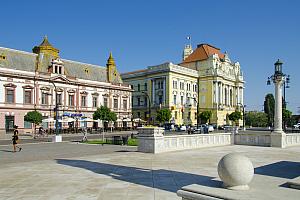Romania travel: Oradea’s must-see Art Nouveau buildings

The elegant city of Oradea, with its unique and rich collection of Art Nouveau architecture, is part of an exclusive club called the Art Nouveau Network, certified as a Cultural Route by the Council of Europe. The city was even nominated among the best Art Nouveau destinations in Europe earlier this year. We outline below some suggestions of the iconic Art Nouveau buildings one must see when visiting Oradea.
First documented in 1113 under the Latin name Varadinum, Oradea was administrated by the Principality of Transylvania, the Ottoman Empire, and the Habsburg Monarchy throughout history.
The iconic city of today was built in the 18th century according to the architectural plans of Viennese engineer Franz Anton Hillebrandt after a fire partially destroyed the city. Hillebrandt followed the Austrian architectural style en vogue at that time and decorated the facades of the buildings accordingly. The style is called Secession and is among the styles that can be admired in the central area of Oradea.
The Moskovits Miksa Palace
The Moskovits Miksa Palace (in opening picture) was built between 1904-1905 according to the plans of architect Kálmán Rimanóczy Jr., commissioned by engineer Moskovits Miksa. It features Lilienstil motifs from the Munich secession, containing several vegetal symbols that can be admired on the facade, alongside the tree of life, Mercury’s scepter, a hand, an anvil, a cogwheel, as well as a compass with a triangle ruler. As to its structure, the building consists of two floors, a basement, a high first floor, and a mezzanine. It can be admired from Traian Street.
Deutsch K. Ignác House
Previously a renowned glassware and porcelain store in the city, the Deutsch House is located at 4 Vasile Alecsandri Street. Some argue that the building was built in 1903 by Rimanóczy Kálmán Jr., while others say it was built around 1906 by Sztarill Ferenc, a famous architect of Oradea at the time.
The glassware and porcelain company became the leading distributor of Transylvania, the Balkans, and Austria starting 1900, and their commercial influence was to be seen on the building’s facade, displayed in large showcases with engraved stained-glass pieces and floral painted porcelain. The store underwent many changes and interior renovations after 1917. The last restoration was in 2018 and displays the main colors of the building, dark blue and gray.
The Palace of Moskovits Adolf and Sons
The Palace of Moskovits Adolf and Sons can be admired from Union Square. It was designed by the brothers Laszlo and Jozsef Vágo in 1912 and has a unique geometric austerity. This facade is a typical signature of the Vágo brothers, designed with the same style as the Guttenberg House in Budapest, a landmark building for their Viennese Secession vision.
The dominant architectural aspect is symbolized by the balconies’ ledges that are built in various sizes and display simple geometric shapes. Moreover, the facade displays idyllic motifs, such as a shepherd with a flute being surrounded by family or crop-gathering symbols.
The Apollo Palace
Another Art Nouveau building designed by the architect Rimanóczy Kálmán, Jr. between 1912 and 1914 is the Apollo Palace. It was built in a location marked by other significant secession buildings and was intended to serve as a coffee house on the first floor while also offering living apartments. It was given the name of Cafeneaua Orașului (The City’s Café) and was the meeting spot of the city’s youth, medics and merchants. After many changes, it is currently operating as a gambling club.
The Black Eagle Palace
Probably the most iconic and photographed building from Oradea, the Black Eagle Palace has a unique secession architectural style in Transylvania.
It was previously the city’s place to host major public events, such as theater plays, political events, balls, and meetings due to its central, strategic position. At first, it consisted only of a small building with three rooms which accommodated the town hall and was later rebuilt and extended, becoming a significant hotel in the city.

Designed by architect Sztarill Ferenc, the building displays an asymmetrical shape that consists of two unequal bodies inspired by the secession style. The Black Eagle Passage has a unique stained glass with an idyllic flying black eagle, which was inspired by the renowned Galleria Vittorio Emanuele in Milan.
The palace is also unique for the combination of architectural styles and the great details, with Secession as the main focus, but also eclectic, neo-baroque elements. The unique details can be admired on all interior elements, starting from the ceilings, windows, doors, panels, and walls to the stained glass.

The palace’s passageway is open to the public and can be visited free of charge. Today, it is Oradea’s center of entertainment, being the heart of day and night-life due to the variety of pubs and cafés, having a magical vibe, at any hour.
iulia@romania-insider.com
(Opening photo: Lazar Adrian Catalin | Dreamstime.com)













